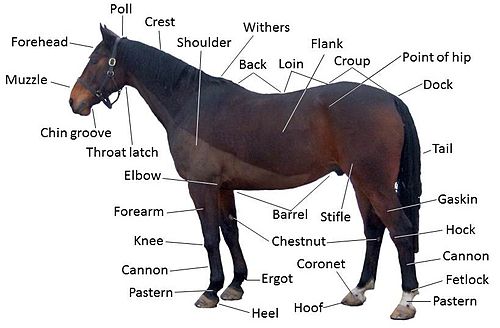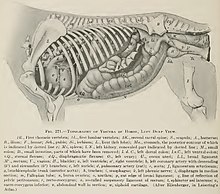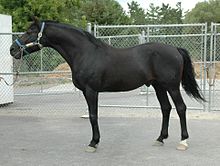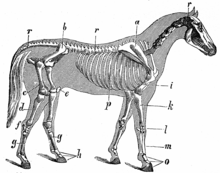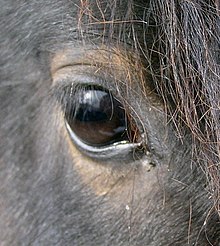Common Infectious Diseases:

Knowledge is the key to disease prevention
Infectious diseases are those diseases that horses can get from each other, or via a vector, such as a
mosquito, which may transmit the disease from horse to horse. Horse owners can vaccinate their horses against many of these diseases, or their veterinarian may administer the vaccinations.
Some vaccines are considered "core" vaccines that cover diseases that all horses need to be immunized against. Some horses may need to be immunized only when there is significant risk that they will be exposed to the disease in their natural environment, or if they may be exposed when traveling, showing, or competing. In addition, horses must be vaccinated at different life stages. Most vaccines need to be given annually.
Tetanus (lockjaw)
Tetanus is caused by a bacterial toxin normally found in the soil and in the feces of horses. The bacteria that produce the tetanus toxin need a decreased oxygen supply to multiply, so any area where there is a deep puncture wound or where a wound has healed over (such as the navel stump of a newborn foal) is an area where tetanus can thrive. Symptoms of tetanus include a protrusion of the third eyelid and stiff neck, progressing to overall muscle stiffness causing a 'sawhorse' stance. Tetanus is often fatal, but a yearly vaccine can prevent it, and the vaccine is a good idea because small cuts can go unnoticed and become infected.
Equine Encephalomyelitis (sleeping sickness)
This is a disease that affects the nervous system, and can be caused by equine encephalomyelitis viruses (Eastern, Western, and Venezuelan), which are carried by mosquitoes. Signs include depression and a high fever, followed by a period when the horse appears blind, nervous and uncoordinated, with muscle tremors, and eventually, complete paralysis. Proper vaccination and good mosquito control are important to help prevent this disease.
This is a disease that affects the nervous system, and can be caused by equine encephalomyelitis viruses (Eastern, Western, and Venezuelan), which are carried by mosquitoes. Signs include depression and a high fever, followed by a period when the horse appears blind, nervous and uncoordinated, with muscle tremors, and eventually, complete paralysis. Proper vaccination and good mosquito control are important to help prevent this disease.
Equine Influenza
This viral disease is spread by inhalation of drops of infective material. Signs include a dry, hacking cough, sudden onset of fever, watery nasal discharge, weakness, loss of appetite and depression. Infection with equine influenza is rarely fatal but can cause problems such as emphysema, pneumonia or bronchitis.
This viral disease is spread by inhalation of drops of infective material. Signs include a dry, hacking cough, sudden onset of fever, watery nasal discharge, weakness, loss of appetite and depression. Infection with equine influenza is rarely fatal but can cause problems such as emphysema, pneumonia or bronchitis.
Equine Herpesvirus (rhinopneumonitis, rhino, viral abortion)
There are 2 types of equine herpesvirus: EHV-1, which causes respiratory disease (fever, cough, nasal discharge), reproductive problems (abortion, stillbirth), and neurological problems (hindlimb weakness, difficulty walking, sometimes paralysis); and EHV-4, which is usually limited to respiratory problems. Once a horse has been infected with EHV-1 or EHV-4, he will always be a carrier, and may shed the virus during times of stress.
There are 2 types of equine herpesvirus: EHV-1, which causes respiratory disease (fever, cough, nasal discharge), reproductive problems (abortion, stillbirth), and neurological problems (hindlimb weakness, difficulty walking, sometimes paralysis); and EHV-4, which is usually limited to respiratory problems. Once a horse has been infected with EHV-1 or EHV-4, he will always be a carrier, and may shed the virus during times of stress.
West Nile Virus
Horses get WNV by being bitten by an infected mosquito; some horses do not show any signs and recover on their own, but in some horses the infection affects the central nervous system and causes signs including fever, weakness or paralysis of the hind limbs, impaired vision, lack of coordination, head pressing, convulsions, inability to swallow, and coma.
Horses get WNV by being bitten by an infected mosquito; some horses do not show any signs and recover on their own, but in some horses the infection affects the central nervous system and causes signs including fever, weakness or paralysis of the hind limbs, impaired vision, lack of coordination, head pressing, convulsions, inability to swallow, and coma.
Rabies
This is a viral infection of the central nervous system, and although it is not common in horses, rabies can be transmitted to horses by the bite of an infected animal such as a skunk, raccoon, fox, dog or bat. Rabies can be transmitted to people. We recommend that you check with your veterinarian regarding recommendations for rabies vaccination for your horse.
This is a viral infection of the central nervous system, and although it is not common in horses, rabies can be transmitted to horses by the bite of an infected animal such as a skunk, raccoon, fox, dog or bat. Rabies can be transmitted to people. We recommend that you check with your veterinarian regarding recommendations for rabies vaccination for your horse.
Strangles
This contagious respiratory disease is caused by a bacterial infection. Signs include a fever, thick, yellow, nasal discharge and swollen, abscessed lymph nodes under the jaws. The infection is spread by infected material from nasal discharge or abscesses contaminating stalls, feed troughs, pastures, etc. Young horses are the most susceptible to strangles.
This contagious respiratory disease is caused by a bacterial infection. Signs include a fever, thick, yellow, nasal discharge and swollen, abscessed lymph nodes under the jaws. The infection is spread by infected material from nasal discharge or abscesses contaminating stalls, feed troughs, pastures, etc. Young horses are the most susceptible to strangles.
Potomac Horse Fever
This disease is a bacterial infection of the blood and tissues. It is much more common in spring, summer and early fall and is only found in certain areas of the country. Signs include a fever, depression, decreased gut sounds, and a profuse, watery diarrhea that can lead to laminitis, colic, dehydration, shock, and death.
Horse Parts and Markings:
If you hang around a stable for any length of time, you'll notice that horse people have a language all their own. This language — which sounds like a foreign tongue to the uninitiated — is what horse people use to describe the intricate details of the horse's body.
Checking out the parts
Nature made horses to be virtual running machines that can reach speeds of nearly 40 miles per hour. The equine body is an impeccably designed combination of muscle and bone in an elegant and graceful package.
People who spend time around horses not only begin to appreciate equine anatomy but also come to understand it. Horse people talk about their horses' bodies the way mechanics talk about cars. In the equine world, if you want to keep up with such conversations, you must know the lingo and the blueprint. Here are some parts of the horse you need to know (see Figure 1 for more.):
- Withers: The area on the horse's back just after the neck but above the shoulders
- Fetlock: The horse's ankle
- Forelock: The hair between the horse's ears that falls onto the forehead
- Hocks: The elbow-like joint of the horse's back legs
- Muzzle: The area of the horse's head that includes the mouth and nostrils
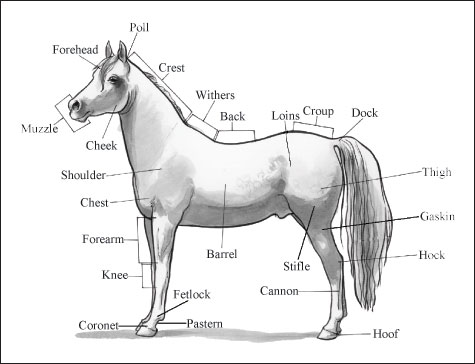
Figure 1: The parts of the horse work together to build a virtual running machine.
Have you heard the expression, No hoof, no horse? Well, it's true. Without healthy hooves, horses can't function well. Becoming familiar with the parts of the horse's hoof (see Figure 2) gives you intimate knowledge of this most important part of the equine body. This knowledge helps you take better care of your horse's tootsies, too.
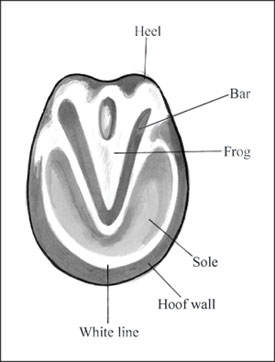
Figure 2: Knowing the parts of the hoof is essential in caring for horses.
Looking at markings
Leg and facial markings are great for helping to identify individual horses. Each marking has a name, and each name is universal among equine aficionados. Figure 3 shows the most common horse facial markings. Keep in mind that the following patterns often have subtle variations.
- Bald: White that starts above the forehead, goes to the muzzle, and extends beyond the bridge of the nose to the side of the face
- Blaze: Wide white area that runs along the bridge of the nose
- Snip: White spot located on the muzzle, between or just below the nostrils
- Star: White spot on the forehead
- Stripe: Narrow white stripe down the center of the face, on the bridge of the nose
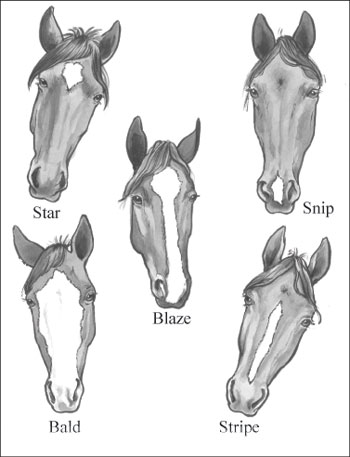
Figure 3: Facial markings can help you identify individual horses.
Figure 4 shows typical white leg markings on horses. They include
- Coronet: A small white band just above the hoof
- Half cannon: A white marking that extends from the edge of the hoof halfway up the middle of the leg
- Half pastern: A white marking that extends from the edge of the hoof halfway up the pastern
- Sock: A white marking that extends from edge of the hoof two-thirds of the way up the leg
- Stocking: A white marking that extends from edge of the hoof to the knee or hock
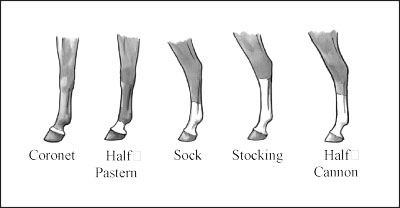
Figure 4: You can find a variety of white leg markings on horses.
Basic Horse Body Parts You Need to Know
Knowing the basic horse body parts opens a whole new world "language." If you don't know the basics, you can quickly find yourself lost and overwhelmed in a typical barn conversation with other students or riders.Barn talk aside, having a grasp of these basic parts of the horse will help you to communicate more effectively with your instructor, trainer, and other equine professionals such as farriers, veterinarians, and equine massage therapists.

When you first start with horses be aware that some horses can startle quickly or may not like their face touched. More explanation on the details of the face can be found below.
Neck- Joins the head to the trunk
He should be able to bend his neck equally well to either side. Often though just like us, they have an easier time bending to one side.
They are also able to flex the neck and "arch" it.
Chest- The chest is the front of the horse and houses the powerful pectoral muscles
Shoulder- Where the shoulder blade is found, and is connected to one of the front leg bones.
Horses don't have a collar bone like humans do. That means their shoulders are attached to the body only by connective tissue, not through any bony connection.
Elbow- The elbow is a joint found near the top of the front leg on the toward the back side of the leg
Knee- The knee is a joint on the front leg joining what we would consider the upper and lower part of the leg.
Most everything found below the knees is tendons, not muscles. An injury below the knee will generally heal slower because of this.
Ankle- The ankle is also known as the fetlock joint.
It is the next joint down from the knee on the front legs and the hocks on the back legs.
Pastern- This is a joint between the hoof and the ankle on both the front and back legs
Hoof- The hoof is below the pastern on all four legs
The hoof is arguably one of the most important horse body parts. In structure it is somewhat comparable to our fingernails. Proper hoof care and shoeing can mean the difference between a sound and unsound (lame) horse.
Withers- The withers are an important part of the horse and are the tallest point of the back.
Horses are measured using the withers as a guiding point.
Back- The top part of the body from the withers back towards the croup.
The strong back is where you are seated to ride. There are many muscles found there. The saddle sits on the back near the withers.
Loin, Croup, and Buttocks- These areas on the back of the horse comprise the "powerhouse."
Barrel- The barrel is the big round area of the horse's body below the back where the ribs are located.
Some horses are referred to as wide or wide barreled because the circumference of the ribs and muscle on both sides of the barrel is very large. This can make saddle fitting a challenge.
Flank- Found on both sides of the body where the hind legs join into the body.
The flanks can be very sensitive body parts and horses can be reactive when touched there
Stifle- This rear leg joint is comparable to our knees in structure
Some horses get a "locking stifle." That is a condition where the joint "catches" temporarily.
Hock- The hocks are found on each rear leg and when seen they look to jut towards the back of the horse.
The hock is prone to injury with overuse from riding as well as from trauma such as receiving a kick from his pasture buddy.
Parts of the Head and Face
Ears - The ears are found at the top of the head and can rotate around to hear sounds in different directions
Horses have excellent hearing. They can also become "ear shy" from improper handling while haltering, clipping, and bridling.
- Always handle the ears gently
Poll- The poll is the area right between and behind the ears.
It is considered the highest point of the horse body parts, as the ears are not counted. When they flex at the poll in response to the bit it is considered a good thing.
Eyes- Horses see differently than we do. Go to this page to see how their vision effects handling and riding
Nostril and Nose - The nose is the part where a horse smells and breathes.
A colored or consistent discharge from the nose can signal infection
Muzzle - The muzzle is the front part of the nose and includes the nostrils
Horses can "curl up" the top lip in order to get a better smell of something. They often do this "flehman" when they think something tastes or smells funny or different.
Jaw- The jaw or cheekbone has a circular appearance
Throatlatch- The skinnier area of the neck right behind the cheekbone
Most bridles have a skinny strap that is called a "throatlatch" that fastens in this area. The horse's windpipe passes through the throat latch area.
PARTS OF A HORSE 

1 - Ear, 2 - Forelock, 3 - Temple, 4 - Eye, 5 - Nose, 6 - Nostril, 7 - Muzzle, 8 - Lips, 9 - Chin, 10 - Chin groove, 11- Branches of jaw, 12 - Cheek, 13 - Occipital crest, 14 - Poll, 15 - Crest, 16 - Neck, 17 - Throat latch, 18 - Jugular groove,19 - Point of shoulder, 20 - Chest, 21 - Shoulder, 22 - Upper arm, 23 - Forearm, 24 - Knee, 25 - Cannon, 26 - Fetlock joint, 27 - Pastern, 28 - Coronet, 29 - Hoof, 30 - Withers, 31 - Back, 32 - Loin, 33 - Point of hip, 34 - Dock of tail, 35 - Croup, 36 - Rips, 37 - Flank, 38 - Brisket, 39 - Belly, 40 - Thigh, haunch, 41 - Buttock, 42 - Point of buttock, 43 - Stifle,44 - Gaskin, 45 - Hock, 46 - Suspensory ligament, 47 - Tendon, 48 - Chestnut, 49 - Elbow, 50 - Heel, 51 - Trapezium, 52- Tail,
- back: the area where the saddle sits, beginning at the end of the withers, extending to the last thoracic vertebrae (colloquially includes the loin or "coupling," though technically incorrect usage)
- barrel: the body of the horse,[1][2] enclosing the rib cage and the major internal organs
- buttock: the part of the hindquarters behind the thighs and below the root of the tail
- cannon or cannon bone: the area between the knee or hock and the fetlock joint, sometimes called the "shin" of the horse, though technically it is the metacarpal III
- chestnut: a callosity on the inside of each leg
- chin groove: the part of the horse's head behind the lower lip and chin, the area that dips down slightly on the lower jaw; area where the curb chain of certain bits is fastened
- coupling: see "Loin" below
- coronet or coronary band: the ring of soft tissue just above the horny hoof that blends into the skin of the leg
- crest: the upper portion of the neck where the mane grows
- croup: the topline of the hindquarters, beginning at the hip, extending proximate to the sacral vertebrae and stopping at the dock of the tail (where the coccygeal vertebrae begin); sometimes called "rump"
- dock: the living part of the tail,[3] consisting of the coccygeal vertebrae, muscles and ligaments. Sometimes used colloquially to refer to the root of the tail, below.
- elbow: The joint of the front leg at the point where the belly of the horse meets the leg. Homologous to the elbow in humans
- ergot: a callosity on the back of the fetlock
- face: the area between the forehead and the tip of the upper lip
- fetlock: sometimes called the "ankle" of the horse, though it is not the same skeletal structure as an ankle in humans; known to anatomists as the metacarpophalangeal (front) or metatarsophalangeal (hind) joint; homologous to the "ball" of the foot or the metacarpophalangeal joints of the fingers in humans
- flank: where the hind legs and the barrel meet, specifically the area right behind the rib cage and in front of the stifle joint
- forearm: the area of the front leg between the knee and elbow, consisting of the fused radius and ulna, and all the tissue around these bones; anatomically, the antebrachium.
- forehead: the area between the poll, the eyes and the arch of the nose
- forelock: the continuation of the mane, which hangs from between the ears down onto the forehead of the horse
- frog: the highly elastic wedge-shaped mass on the underside of the hoof, which normally makes contact with the ground every stride, and supports both the locomotion and circulation of the horse
- gaskin: the large muscle on the hind leg, just above the hock, below the stifle, homologous to the calf of a human
- girth or heartgirth: the area right behind the elbow of the horse, where the girth of the saddle would go; this area should be where the barrel is at its greatest diameter in a properly-conditioned horse that is not pregnant or obese
- hindquarters: the large, muscular area of the hind legs, above the stifle and behind the barrel
- hock: the tarsus of the horse (hindlimb equivalent to the human ankle and heel), the large joint on the hind leg
- hoof: the foot of the horse; the hoof wall is the tough outside covering of the hoof that comes into contact with the ground and is, in many respects, a much larger and stronger version of the human fingernail
- jugular groove: the line of indentation on the lower portion of the neck, can be seen from either side, just above the windpipe; beneath this area run the jugular vein, the carotid artery and part of the sympathetic trunk
- knee: the carpus of the horse (equivalent to the human wrist), the large joint in the front legs, above the cannon bone
- loin: the area right behind the saddle, going from the last rib to the croup, anatomically approximate to the lumbar spine
- mane: long and relatively coarse hair growing from the dorsal ridge of the neck
- muzzle: the chin, mouth, and nostrils of the face
- pastern: the connection between the coronet and the fetlock, made up of the middle and proximal phalanx
- poll: commonly refers to the poll joint at the beginning of the neck, immediately behind the ears, a slight depression at the joint where the atlas (C1) meets the occipital crest; anatomically, the occipital crest itself is the "poll"
- root of the tail or root of the dock: the point where the tail is "set on" (attached) to the rump;[3] Sometimes also called the "dock"
- shoulder: made up of the scapula and associated muscles, runs from the withers to the point of shoulder (the joint at the front of the chest, i.e. the glenoid); the angle of the shoulder has a great effect on the horse's movement and jumping ability, and is an important aspect of equine conformation
- splints: bones found on each of the legs, on either side of the cannon bone (8 total); partially vestigial, these bones support the corresponding carpal bones in the forelimb, and the corresponding tarsal bones in the hindlimb;[4] anatomically referred to asMetacarpal/Metatarsal II (on the medial aspect (inside)) and IV (on the lateral aspect (outside))
- stifle: corresponds to the knee of a human, consists of the articulation between femur and tibia, as well as the articulation between patella and femur
- tail: the long hairs which grow from the dock; may also include the dock[3]
- throatlatch[5][6][7][8][9][10] (also, throttle, throatlash[citation needed], throat[11] ): the point at which the windpipe meets the head at the underside of the jaw,[3] corresponding to where the eponymous part of a bridle goes.[12]
- withers: the highest point of the thoracic vertebrae, the point just above the tops of the shoulder blades, seen best with horse standing square and head slightly lowered; the height of the horse is measured at the withers.
